Page 174 of 527
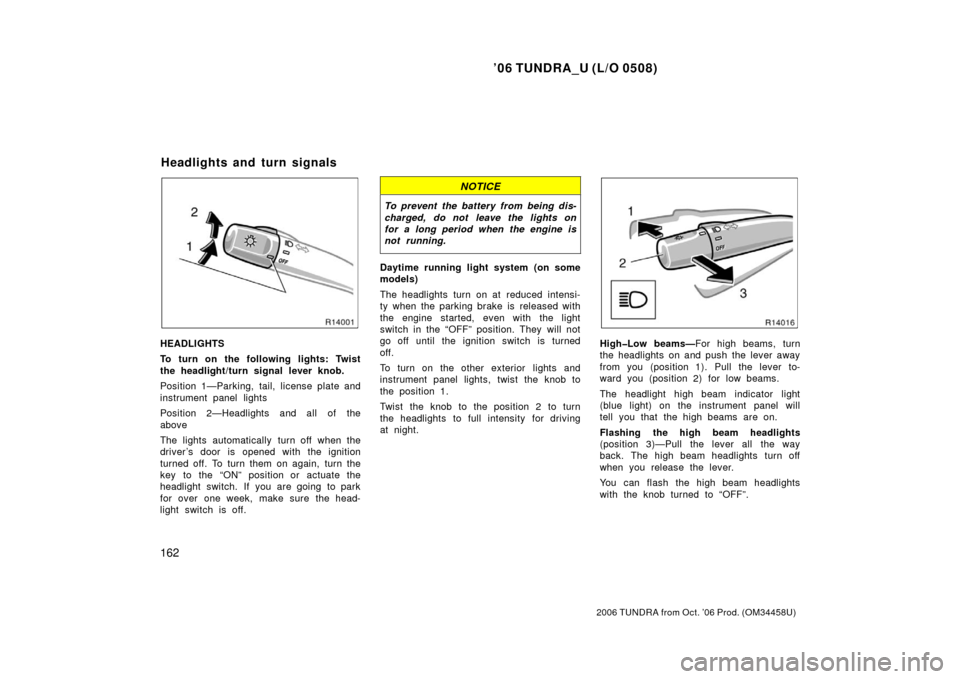
’06 TUNDRA_U (L/O 0508)
162
2006 TUNDRA from Oct. ’06 Prod. (OM 34458U)
HEADLIGHTS
To turn on the following lights: Twist
the headlight/turn signal lever knob.
Position 1—Parking, tail, license plate and
instrument panel lights
Position 2—Headlights and all of the
above
The lights automatically turn off when the
driver ’s door is opened with the ignition
turned off. To turn them on again, turn the
key to the “ON” position or actuate the
headlight switch. If you are going to park
for over one week, make sure the head-
light switch is off.
NOTICE
To prevent the battery from being dis-
charged, do not leave the lights on
for a long period when the engine is
not running.
Daytime running light system (on some
models)
The headlights turn on at reduced intensi-
ty when the parking brake is released with
the engine started, even with the light
switch in the “OFF” position. They will not
go off until the ignition switch is turned
off.
To turn on the other exterior lights and
instrument panel lights, twist the knob to
the position 1.
Twist the knob to the position 2 to turn
the headlights to full intensity for driving
at night.
High�Low beams—For high beams, turn
the headlights on and push the lever away
from you (position 1). Pull the lever to-
ward you (position 2) for low beams.
The headlight high beam indicator light
(blue light) on the instrument panel will
tell you that the high beams are on.
Flashing the high beam headlights
(position 3)—Pull the lever all the way
back. The high beam headlights turn off
when you release the lever.
You can flash the high beam headlights
with the knob turned to “OFF”.
Headlights and turn signals
Page 185 of 527
’06 TUNDRA_U (L/O 0508)
173
2006 TUNDRA from Oct. ’06 Prod. (OM 34458U)
OPERATION OF INSTRUMENTS AND
CONTROLS
Gauges, Meters and Service reminder indicators
Fuel gauge 174
. . . . . . . . . . . . . . . . . . . . . . . . . . . . . . . . . . . . .\
. . . . . . . . . . .
Engine coolant temperature gauge 174
. . . . . . . . . . . . . . . . . . . . . . . . . . .
Oil pressure gauge 175
. . . . . . . . . . . . . . . . . . . . . . . . . . . . . . . . . . . . \
. . . . .
Vo ltme te r 176
. . . . . . . . . . . . . . . . . . . . . . . . . . . . . . . . . . . . \
. . . . . . . . . . . . . .
Tachometer 176
. . . . . . . . . . . . . . . . . . . . . . . . . . . . . . . . . . . . \
. . . . . . . . . . . .
Odometer and two trip meters 177
. . . . . . . . . . . . . . . . . . . . . . . . . . . . . . . .
Service reminder indicators and warning buzzers 178
. . . . . . . . . . . . . .
SECTION 1� 6
Page 186 of 527
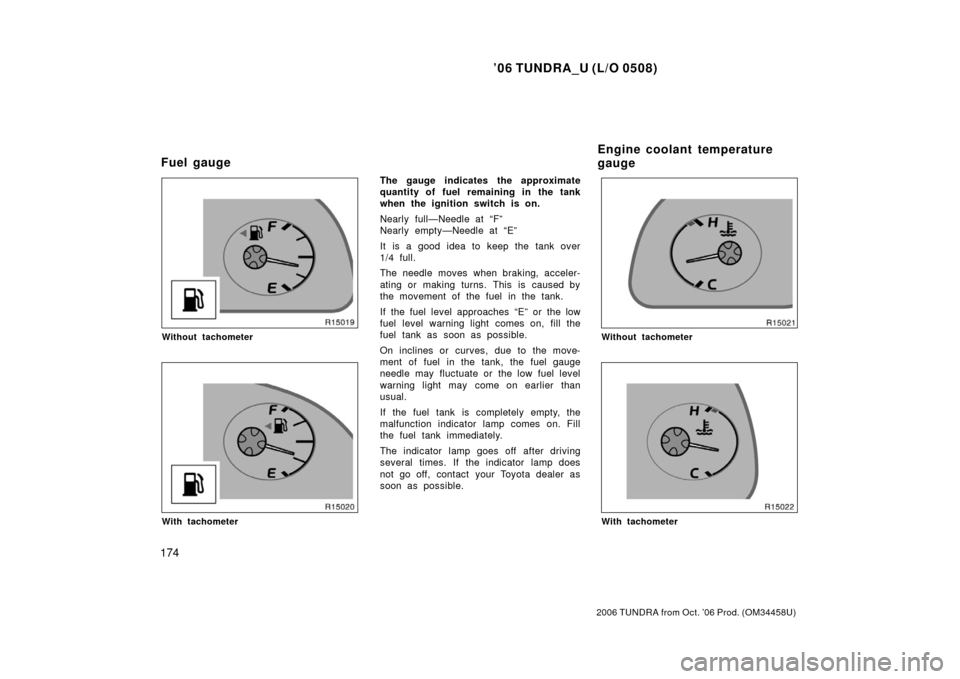
’06 TUNDRA_U (L/O 0508)
174
2006 TUNDRA from Oct. ’06 Prod. (OM 34458U)
Without tachometer
With tachometer
The gauge indicates the approximate
quantity of fuel remaining in the tank
when the ignition switch is on.
Nearly full—Needle at “F”
Nearly empty—Needle at “E”
It is a good idea to keep the tank over
1/4 full.
The needle moves when braking, acceler-
ating or making turns. This is caused by
the movement of the fuel in the tank.
If the fuel level approaches “E” or the low
fuel level warning light comes on, fill the
fuel tank as soon as possible.
On inclines or curves, due to the move-
ment of fuel in the tank, the fuel gauge
needle may fluctuate or the low fuel level
warning light may come on earlier than
usual.
If the fuel tank is completely empty, the
malfunction indicator lamp comes on. Fill
the fuel tank immediately.
The indicator lamp goes off after driving
several times. If the indicator lamp does
not go off, contact your Toyota dealer as
soon as possible.
Without tachometer
With tachometer
Fuel gauge Engine coolant temperature
gauge
Page 187 of 527
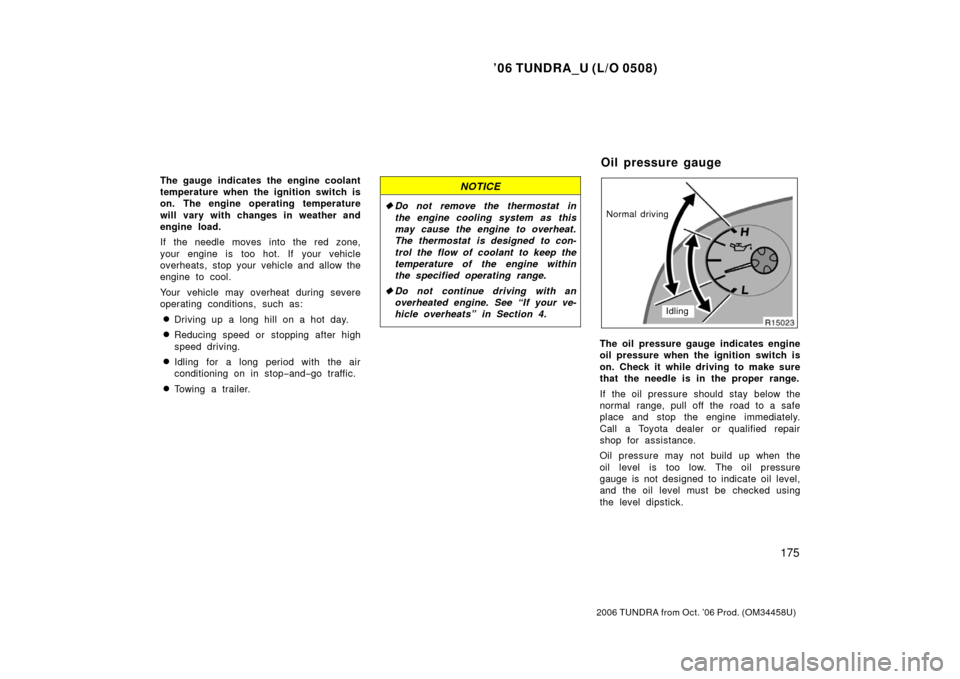
’06 TUNDRA_U (L/O 0508)
175
2006 TUNDRA from Oct. ’06 Prod. (OM 34458U)
The gauge indicates the engine coolant
temperature when the ignition switch is
on. The engine operating temperature
will vary with changes in weather and
engine load.
If the needle moves into the red zone,
your engine is too hot. If your vehicle
overheats, stop your vehicle and allow the
engine to cool.
Your vehicle may overheat during severe
operating conditions, such as:
�Driving up a long hill on a hot day.
�Reducing speed or stopping after high
speed driving.
�Idling for a long period with the air
conditioning on in stop−and− go traffic.
�Towing a trailer.
NOTICE
�Do not remove the thermostat in
the engine cooling system as this
may cause the engine to overheat.
The thermostat is designed to con-
trol the flow of coolant to keep the
temperature of the engine within
the specified operating range.
� Do not continue driving with an
overheated engine. See “If your ve-
hicle overheats” in Section 4.
Idling
Normal driving
The oil pressure gauge indicates engine
oil pressure when the ignition switch is
on. Check it while driving to make sure
that the needle is in the proper range.
If the oil pressure should stay below the
normal range, pull off the road to a safe
place and stop the engine immediately.
Call a Toyota dealer or qualified repair
shop for assistance.
Oil pressure may not build up when the
oil level is too low. The oil pressure
gauge is not designed to indicate oil level,
and the oil level must be checked using
the level dipstick.
Oil pressure gauge
Page 188 of 527
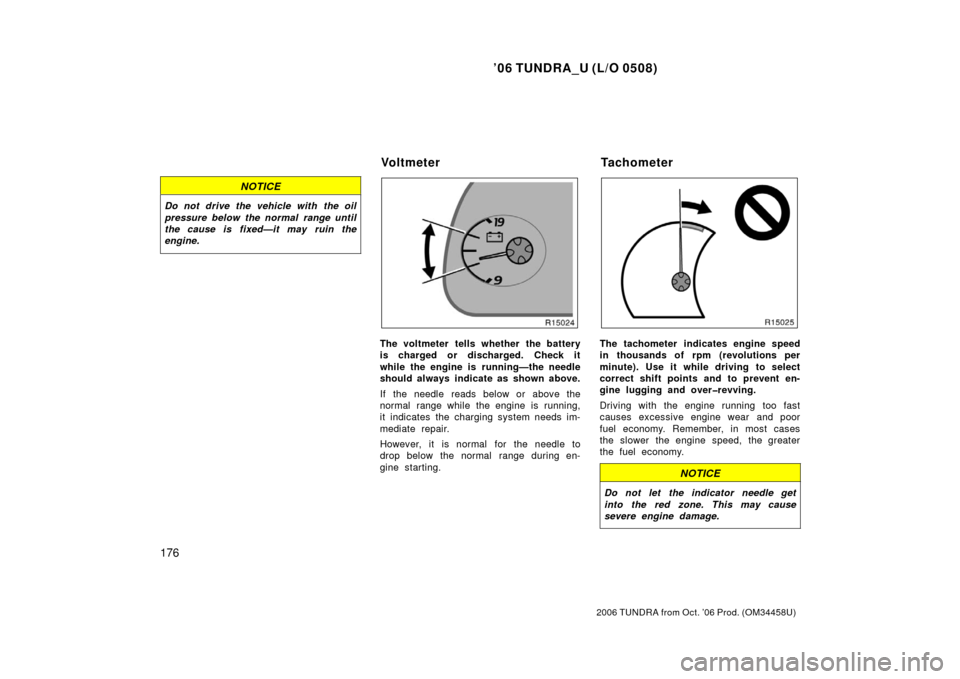
’06 TUNDRA_U (L/O 0508)
176
2006 TUNDRA from Oct. ’06 Prod. (OM 34458U)
NOTICE
Do not drive the vehicle with the oil
pressure below the normal range until
the cause is fixed—it may ruin the
engine.
The voltmeter tells whether the battery
is charged or discharged. Check it
while the engine is running—the needle
should always indicate as shown above.
If the needle reads below or above the
normal range while the engine is running,
it indicates the charging system needs im-
mediate repair.
However, it is normal for the needle to
drop below the normal range during en-
gine starting.The tachometer indicates engine speed
in thousands of rpm (revolutions per
minute). Use it while driving to select
correct shift points and to prevent en-
gine lugging and over�revving.
Driving with the engine running too fast
causes excessive engine wear and poor
fuel economy. Remember, in most cases
the slower the engine speed, the greater
the fuel economy.
NOTICE
Do not let the indicator needle get
into the red zone. This may cause
severe engine damage.
Voltmeter Tachometer
Page 191 of 527
’06 TUNDRA_U (L/O 0508)
179
2006 TUNDRA from Oct. ’06 Prod. (OM 34458U)
If the indicator or buzzer comes on...Do this.
(h)orTake vehicle to Toyota dealer.
(i)Take vehicle to Toyota dealer.
(j)Close all doors.
(k)Take vehicle to Toyota dealer immediately.
(l)Adjust tire inflation pressure (including spare tire). If the light blinks, contact Toyota
dealer.
(m)Stop and check.
(n)Add washer fluid.
(o)Replace engine oil.
Page 193 of 527
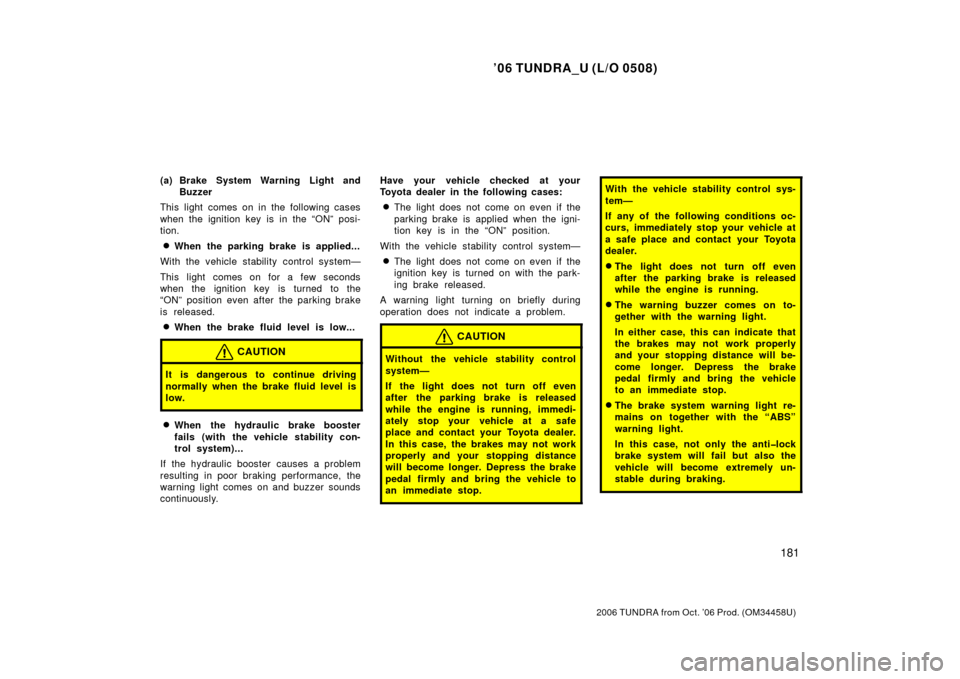
’06 TUNDRA_U (L/O 0508)
181
2006 TUNDRA from Oct. ’06 Prod. (OM 34458U)
(a) Brake System Warning Light and
Buzzer
This light comes on in the following cases
when the ignition key is in the “ON” posi-
tion.
�When the parking brake is applied...
With the vehicle stability control system—
This light comes on for a few seconds
when the ignition key is turned to the
“ON” position even after the parking brake
is released.
�When the brake fluid level is low...
CAUTION
It is dangerous to continue driving
normally when the brake fluid level is
low.
�When the hydraulic brake booster
fails (with the vehicle stability con-
trol system)...
If the hydraulic booster causes a problem
resulting in poor braking performance, the
warning light comes on and buzzer sounds
continuously. Have your vehicle checked at your
Toyota dealer in the following cases:
�The light does not come on even if the
parking brake is applied when the igni-
tion key is in the “ON” position.
With the vehicle stability control system—
�The light does not come on even if the
ignition key is turned on with the park-
ing brake released.
A warning light turning on briefly during
operation does not indicate a problem.
CAUTION
Without the vehicle stability control
system—
If the light does not turn off even
after the parking brake is released
while the engine is running, immedi-
ately stop your vehicle at a safe
place and contact your Toyota dealer.
In this case, the brakes may not work
properly and your stopping distance
will become longer. Depress the brake
pedal firmly and bring the vehicle to
an immediate stop.
With the vehicle stability control sys-
tem—
If any of the following conditions oc-
curs, immediately stop your vehicle at
a safe place and contact your Toyota
dealer.
�The light does not turn off even
after the parking brake is released
while the engine is running.
�The warning buzzer comes on to-
gether with the warning light.
In either case, this can indicate that
the brakes may not work properly
and your stopping distance will be-
come longer. Depress the brake
pedal firmly and bring the vehicle
to an immediate stop.
�The brake system warning light re-
mains on together with the “ABS”
warning light.
In this case, not only the anti�lock
brake system will fail but also the
vehicle will become extremely un-
stable during braking.
Page 194 of 527

’06 TUNDRA_U (L/O 0508)
182
2006 TUNDRA from Oct. ’06 Prod. (OM 34458U)
With the vehicle stability control sys-
tem—
Any of the following conditions may oc-
cur, but do not indicate the malfunc-
tion:
�The light may stay on for about 60
seconds after the ignition key is turned
to the “ON” position. It is normal if it
turns off after a while.
�Depressing the brake pedal repeatedly
may turn on the warning light and
buzzer. It is normal if the light turns off
and the buzzer stops sounding after a
few seconds.
�You may hear a small sound in the
engine compartment after the engine is
started or the brake pedal is depressed
repeatedly. This is a pump pulsating
sound of the brake system, and it is
not a malfunction. (b) Driver’s Seat Belt Reminder Light
and Buzzer
The light and buzzer act as a reminder to
buckle up the driver’s seat belt.
Once the ignition key is turned to “ON” or
“START”, the reminder light flashes and
buzzer sounds if the driver ’s seat belt is
not fastened. Unless the driver fastens the
belt, the light continues flashing and the
buzzer stops after about 4 to 8 seconds.
(c) Front Passenger ’s Seat Belt Re- minder Light
The light acts as a reminder to have the
front passenger buckle up the seat belt.
Once the ignition key is turned to “ON”,
the reminder light flashes if a passenger
sits in the front passenger seat and does
not fasten the seat belt.
If luggage or other load is placed on the
front passenger seat, depending on its
weight, the reminder light may come on. (d) Charging System Warning Light
This warning light comes on when the
ignition switch is turned to the “ON” posi-
tion, and goes off when the engine is
started.
When there are problems in the charging
system while the engine is r
unning, the
warning light comes on.
NOTICE
When the charging system warning
light comes on while the engine is
running, malfunctions such as the en-
gine drive belt being broken may have
occurred. If the warning light comes
on, immediately stop the vehicle in a
safe place and contact your Toyota
dealer.